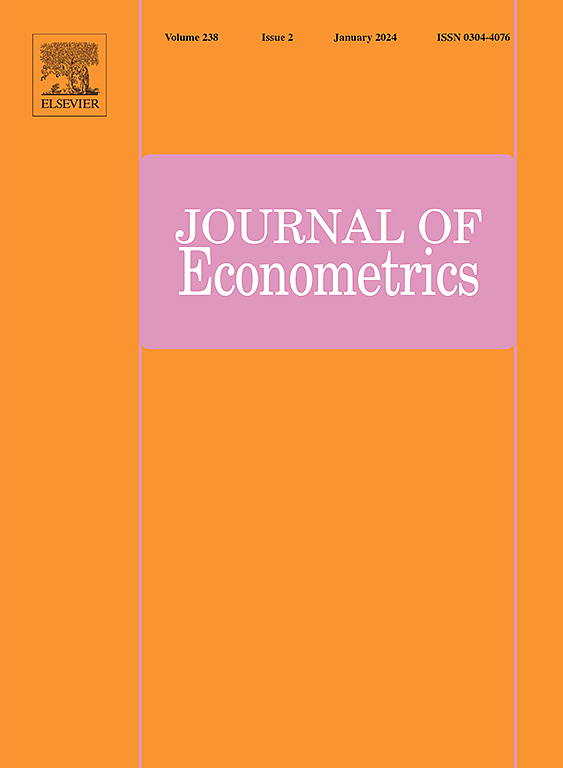Exogeneity tests and weak identification in IV regressions: Asymptotic theory and point estimation
IF 9.9
3区 经济学
Q1 ECONOMICS
引用次数: 0
Abstract
This paper provides new insights on exogeneity tests in linear IV models and their use for estimation, when identification fails or may not be strong. We make two main contributions. First, we show that Durbin–Wu–Hausman (DWH) and Revankar–Hartley (RH) exogeneity tests have correct level asymptotically, even when the first-stage coefficient matrix (which controls identification) is rank-deficient. We provide necessary and sufficient conditions under which these tests are consistent. In particular, we show that test consistency can hold even when identification fails, provided at least one component of the structural parameter vector is identifiable. Second, we study point estimation after estimator (or model) selection, when the outcome of a DWH/RH test determines whether OLS or an IV method is employed in the second-stage. For this purpose, we use (non-local) concepts of asymptotic bias, asymptotic mean squared error (AMSE), and asymptotic relative efficiency (ARE), which remain applicable even when the estimators considered do not have moments (as can happen for 2SLS) or may be inconsistent. We study the asymptotic properties of OLS, 2SLS, and pretest estimators which select OLS or 2SLS based on the outcome of a DWH/RH test. We show that: (i) OLS typically dominates 2SLS estimator asymptotically for MSE across a broad spectrum of cases, including weak identification and moderate endogeneity; (ii) exogeneity-pretest estimators exhibit consistently good performance and asymptotically dominate both OLS and 2SLS. The proposed theoretical findings are documented by Monte Carlo simulations.
IV回归的外生性检验与弱辨识:渐近理论与点估计
本文提供了对线性IV模型中的外生性检验及其用于估计的新见解,当识别失败或可能不强时。我们做出了两个主要贡献。首先,我们证明了Durbin-Wu-Hausman (DWH)和Revankar-Hartley (RH)外生性检验具有渐近的正确水平,即使当第一阶段系数矩阵(控制识别)是秩不足的。我们提供了这些测试一致的必要和充分条件。特别是,我们表明,即使识别失败,只要结构参数向量的至少一个组件是可识别的,测试一致性也可以保持。其次,我们研究了估计器(或模型)选择后的点估计,当DWH/RH测试的结果决定第二阶段是否采用OLS或IV方法时。为此,我们使用(非局部)渐近偏差、渐近均方误差(AMSE)和渐近相对效率(ARE)的概念,即使考虑的估计量没有矩(可能发生在2SLS)或可能不一致时,这些概念仍然适用。我们研究了OLS、2SLS和基于DWH/RH检验结果选择OLS或2SLS的预检验估计的渐近性质。我们发现:(i)在广泛的情况下,OLS通常在MSE的渐近估计中优于2SLS估计,包括弱识别和中等内生性;(ii)外生性预检验估计器表现出一致的良好性能,并逐渐主导OLS和2SLS。提出的理论发现是由蒙特卡罗模拟证明。
本文章由计算机程序翻译,如有差异,请以英文原文为准。
求助全文
约1分钟内获得全文
求助全文
来源期刊

Journal of Econometrics
社会科学-数学跨学科应用
CiteScore
8.60
自引率
1.60%
发文量
220
审稿时长
3-8 weeks
期刊介绍:
The Journal of Econometrics serves as an outlet for important, high quality, new research in both theoretical and applied econometrics. The scope of the Journal includes papers dealing with identification, estimation, testing, decision, and prediction issues encountered in economic research. Classical Bayesian statistics, and machine learning methods, are decidedly within the range of the Journal''s interests. The Annals of Econometrics is a supplement to the Journal of Econometrics.
 求助内容:
求助内容: 应助结果提醒方式:
应助结果提醒方式:


